Highly concentrated active pharmaceutical ingredients and toxic chemicals pose a high risk potential. Requirements for the protection of plant operators are increasing and the need for safe and efficient containment solutions is growing.
For example, when emptying raw materials from big bags: If fine, dusty products are processed, specific limit values for substance contamination must be complied with.
When handling highly effective or even toxic products, safety is paramount. Containment is mandatory. But the specifications and systems are often complicated and error-prone. The JEL SmartCon ES containment connection system enables simple yet safe big bag emptying up to OEB 4.
And not only in the pharmaceutical sector, containment systems for big bag emptying are increasingly being used in other industries as well. Their development focuses on three aspects in particular: the continuous preservation of the containment, the simple and safe operability and the quick change of big bags without containment breakage.
One variant are single-use or foil disposable systems for big bag emptying. An integrated foil system enables the continuous maintenance of the containment. These emptying systems demonstrably offer plant operators many advantages and are generally less complex and costly than multi-use solutions. Engelsmann’s SmartCon ES big bag emptying system can be used in containment areas up to OEB4. The system allows the operator to connect a big bag, empty it and change the bag in a few simple steps. The process is supported by a touchscreen control system that visually guides the operator through the work steps and largely eliminates operating errors thanks to safety features such as two-hand operation or the special programming logic.
A special function of the JEL SmartCon ES system is the integrated pressure test, which detects even the smallest damage of the big bag outlet. Only when the pressure test is passed the operator can continue with the emptying process. Engelsmann’s solution uses an endless foil system in combination with clamping and cutting tools for the operator when changing containers. Since many work steps are automated by the control system and the system is easy to operate after a short briefing, the emptying and pack change can be completed in a relatively short time. This enables high feed rates when emptying big bags, even under containment conditions.
The big bag emptying system is developed as a compact containment system, does not require more installation space (height and width) than conventional emptying stations and can also be easily integrated into existing plants.
Core components and an exemplary big bag emptying process
Big bag emptying stations consist of a stable frame in which the big bag is inserted from above, e.g. with the help of a crane track. The emptying module is located below the big bag and is connected to the outlet of the big bag via a docking mechanism to form a closed system. In the case of products with unfavourable flow properties, additional discharge aids can be integrated on the side or below the big bag on the frame. They act on the big bag from the outside and thus support the product flow.
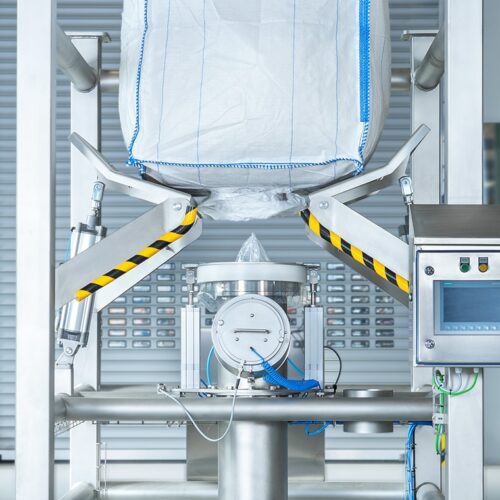
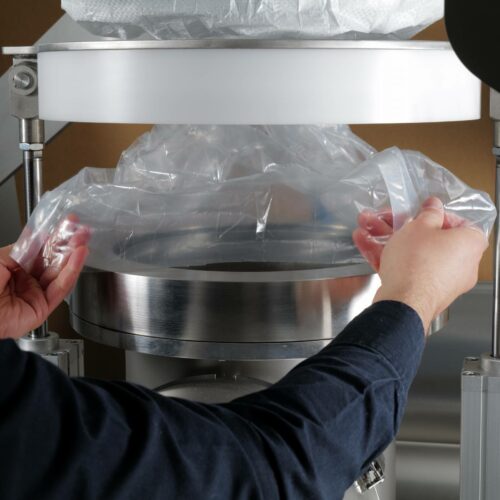
First critical interface: connection of the big bag
In order to ensure a consistently high level of containment throughout the entire discharge process, certain critical interfaces must be designed in such a way that only as many substance particles can escape from the system into the plant environment as specified by the limit value for the respective product.
The first critical moment is at the beginning, when the operator connects the big bag outlet to the connection system. The mechanism must be designed to create a stable connection between the big bag outlet and the emptying module that holds securely throughout the emptying process. At all times, an optimal seal to the outside must also be ensured once the product flow has been initiated by opening the outlet. As the product falls vertically downwards from the big bag into the module, this is also the section of the emptying process where the greatest dust formation occurs.
Critical interfaces afterwards
In addition to the optimal sealing of the entire emptying module to the outside, material transfer points, i.e. connections between the module and downstream conveyor or storage technology, are further critical interfaces. For the continuous maintenance of the containment, the emptying module and the systems connected to it must therefore form a closed unit. This is achieved by constructive measures and the use of suitable connecting elements.
How it works: using the JEL SmartCon system – explained step by step
Step 1
The big bag to be emptied is placed in the emptying station and secured against falling. Its outlet spout remains closed for the time being. The dust-tight film residue of the previously emptied big bag that remains in the JEL SmartCon ES module is only removed when a new big bag is connected. This is important to maintain the tightness of the system.
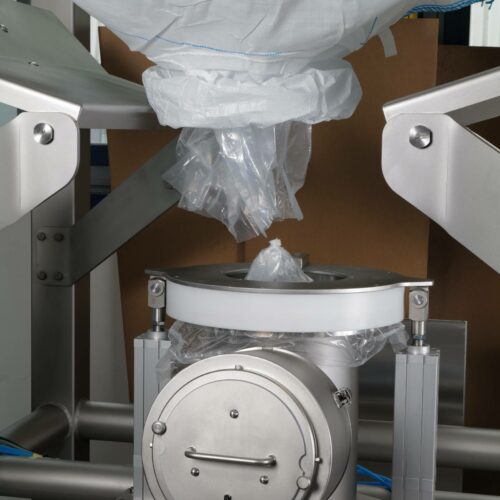
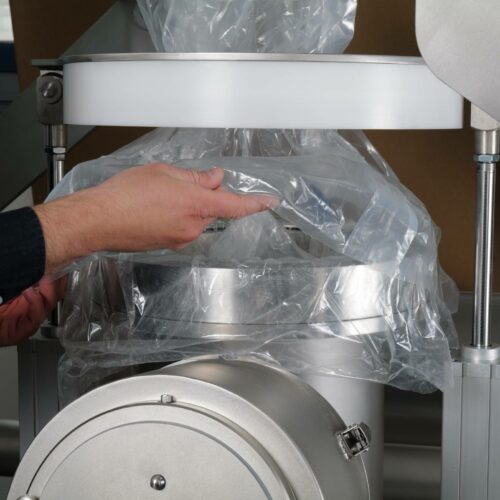
Step 2
To connect the outlet of the new big bag, the press-on cover of the connection module is raised, a piece of continuous foil is pulled out of the storage container and unfolded over the emptying hopper.
Now the inliner of the big bag to be emptied can be connected. To do this, the foil inliner of the big bag is pulled downwards out of the outlet spout and put over the emptying unit.
Step 3
The pressure plate is automatically lowered again and the big bag spout is securely pre-fixed in the connection module. Pneumatic seals now fix the big bag outlet firmly to the docking system, creating a dust-tight and closed system. Incorrect operation is almost impossible.
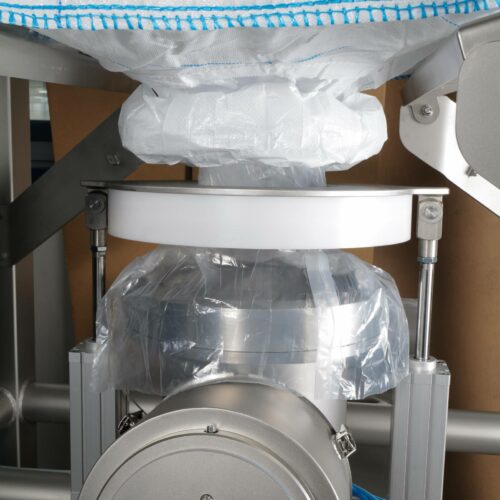
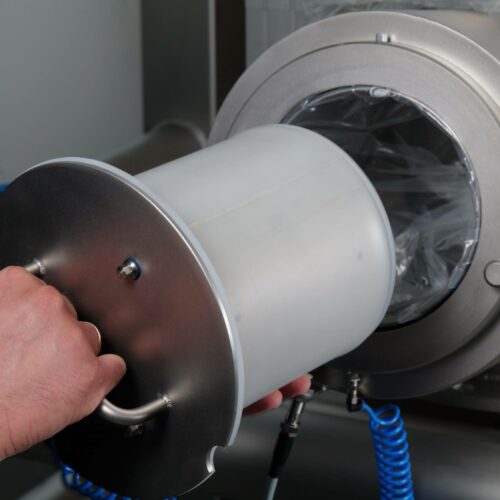
Step 4
Now the cover of the engagement socket can be opened without tools. The containment is still retained.
Step 5
The operator can safely reach for the separated film remnants of the previously emptied big bag via a gripping spout, also equipped with an endless film system, and pull it out very easily – without breaking the containment.
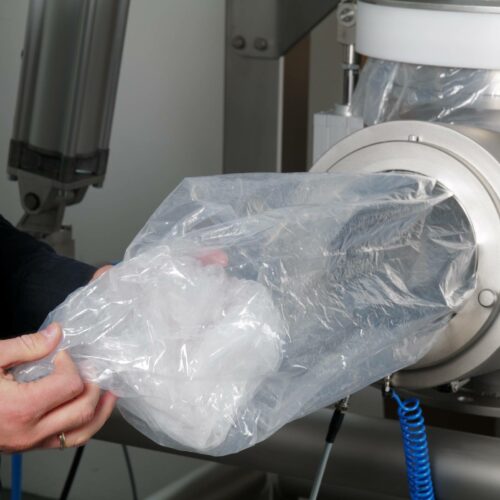
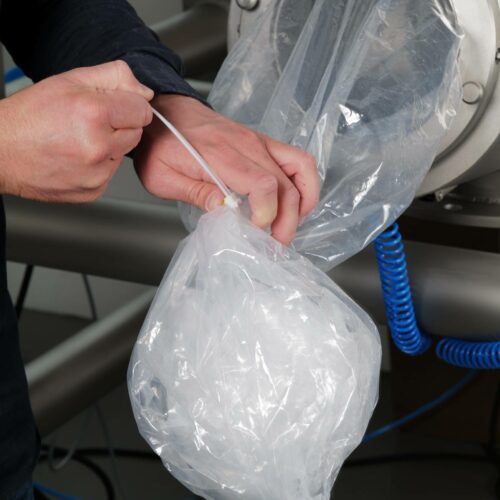
Step 6
The continuous foil with the inliner residue inside is tied, cut off and then disposed of. The operator uses a combination of special clamping and cutting tools for the separation.
Step 7
Once the foil residues from the previous big bag emptying process have been disposed of, the cover of the access spout is closed again so that it is dust-tight. The contamination-free emptying can be started – for safety reasons by two-hand operation.
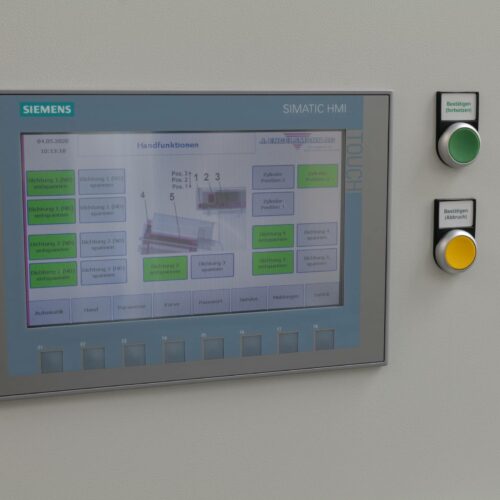
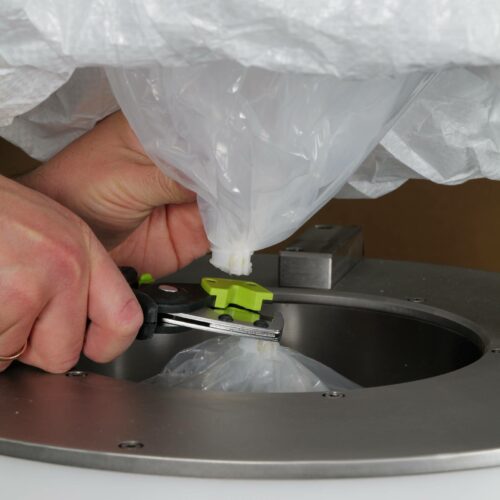
Step 8
After ending the emptying process, the big bag outlet is tied above the docking system and cut off with a special cutting tool.
Optional pressure test
A special function is the integrated pressure test (optional). This detects even the slightest damage to the big bag outlet, which could cause the smallest particles of material to escape to the outside unnoticed. The operator can only start the emptying process after the pressure test has been passed.
Hygienic design for optimum cleanability: If the critical points are optimally solved, the entire big bag emptying process, including the container change and the discharge of the product, functions as a completely closed system.
Hygienic design is also a basic requirement for optimum cleanability in containment systems for big bag emptying. Due to a low number of components with product contact in the interior, the cleaning effort can be kept to a minimum.
In the case of particularly aggressive products, the choice of optimum materials and surface treatment must ensure that the surfaces with product contact are correspondingly resistant and that no contamination of the product occurs through abrasion. Manufacturers of big bag emptying stations for containment areas such as Engelsmann therefore offer different material designs for their components. For stainless steel components in contact with the product, V4A quality has become the standard. Sealing materials that come into contact with the product must also be suitable for the respective application and, of course, conform to the relevant directives.
Since the control system automates many work steps and the system is easy to operate after a brief introduction, emptying and changing containers can be done in a short time with a little practice. The JEL SmartCon ES containment system is particularly easy to handle. This minimises set-up times and enables a high feed rate in the process.
If the containment system is also compactly designed, no more installation space is required in terms of height and width than for conventional discharge stations. Such solutions can also be easily integrated into existing plants.

